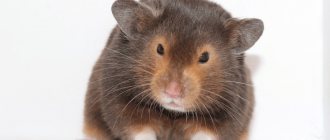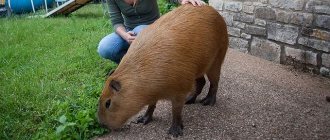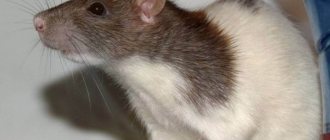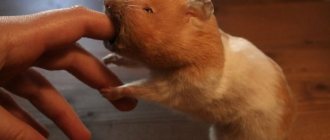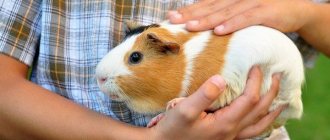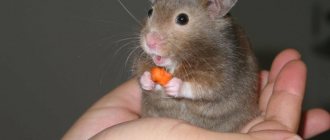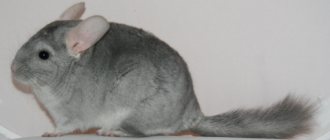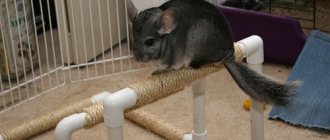Livestock » Ferrets
0
3349
Article rating
Kira Stoletova
Ferrets are nimble animals from the mustelidae family. With their cute faces and lively character, they can make you fall in love at first sight. Before you get this unusual animal, you need to figure out what breeds of ferrets exist and how they differ from each other.
Colors and breeds of decorative ferrets
Types of ferrets
All ferrets living in the world can be divided into four main species. This is the steppe, as well as forest, blackfoot and fret. Let's look at all of these above types of ferrets in more detail.
Male steppe ferrets are much larger than females
Stepnoy
These are quite large animals; an adult usually has a body length of 52-56 cm, but the average weight is two kilos. This species is also called light or white ferret.
Males of this species are slightly larger than females. The first one also has a bushier tail. On average, the tail length of animals of this species is 18 cm.
The coat is long, but not particularly thick. The undercoat is quite visible. The main hair is dark, usually brown, but the undercoat is light. The limbs and tail of the animal are usually dark in color, but the muzzle is. As if “dressed” in a mask.
As an exception, among representatives of this species there may also be completely white animals, which are called “albinos”.
We draw your attention to the fact that steppe ferrets are fertile. One litter can have 10 babies, and in some cases even 18.
REFERENCE! Representatives of this species of ferrets go fishing only at night. An adult can sleep up to 15 hours. With such a long sleep, the animals compensate for their usually active night hunting.
Forest ones are also called ordinary
Forest
This animal is also called ordinary. It is significantly smaller in size than the previous type. The body length of the animal can reach a maximum of 48 cm. Weight varies from 400 grams. up to 1.5 kg.
Compared to its steppe counterpart, the coat color of the forest ferret does not have such a contrast. Usually the main color of the animal's coat is black-brown, but the paws, tail and head are usually black. The forest representative of the mustelid family also has a kind of mask on its face.
This breed is endangered
Blackfoot
Ferrets were first spotted in 1851. Currently, the animals are endangered, so it is extremely difficult to find them in nature.
The lifespan of this species in the wild is quite short and amounts to 3-4 years. But in captivity, the black-footed ferret can live 7-8 years.
Frets are usually called pets
Fretka
Typically, ferrets of this genus are called domestic ferrets. After all, it is a domesticated species of the mustelidae family. The body length of an adult ferret can reach 51 cm, but the weight varies between 700 grams and 2 kilograms.
Group of pastel selfies
The group is characterized by the fact that the spine (regardless of its color) is completely colored. Due to this, the frets of the group lack shading. The base color ranges from dark brown in chocolate to snowy white in Dew.
Chocolate self Chocolate solid Champagne self Cinnamon self DewRange, habitats
Unlike other varieties of ferrets, the steppe ferret prefers to be located in open areas. It is also worth noting that it rarely approaches a person’s home.
As for places of “residence,” ferrets of this species can be seen in the Czech Republic and Slovakia, Hungary and Romania, Ukraine, and Moldova. Also, steppe ferrets live in the forest-steppes of Russia and the Far East, but in its European part.
The wood ferret usually lives on the edges of the forest, or in pastures. The animals get along well with people. Therefore, they are very often kept as pets. This species is most widespread in Eurasia and the northwestern part of the African continent. The forest ferret can also be found in Russia, Ukraine, and China.
But the black-footed ferret can safely be called the “indigenous” animal of North America. Although, as we have already noted, ferrets of this species are rarely found in nature, their populations can still be found in the US state called South Dakota, in the northeast of Montana and in Wyoming.
Reproduction and offspring
Sexual maturity in ferrets occurs quite early, maximum within 1 year of life. The breeding process of ferrets takes about six months, and the beginning of the process depends on living conditions. Steppe ferrets begin to take care of the birth of future offspring already in March, and forest ferrets - somewhere in mid-spring or even early summer.
These animals do not have signs of a mating ritual, so the mating process takes place vigorously and one might think that the ferrets are fighting. As a result of this process, males can cause minor injuries to females. This is where the role of males in the appearance of future offspring ends, since they do not take any part in raising the future generation.
It is important to know! The female carries her future offspring for one and a half months. From 4 to 20 puppies are born, depending on the number of births the female has. The puppies weigh within 10 grams and are absolutely helpless and blind.
The female feeds her cubs with milk for a maximum of 3 months, but already at the age of one month meat appears in their diet. After about a month, babies' eyes open. After stopping milk feeding, the puppies begin to hunt together with their mother. After six months of life, the offspring begins their own life, independent of their parents.
Colors
Animals are quite diverse in coat color. These animals can be a solid white color, or they can impress with their deep brown fur color. But it is worth noting that depending on the color, animals also have different temperaments.
Albinos are very active
Albino
An albino ferret usually has white fur without spots and a pink nose. The eyes of such an animal are usually reddish in color. It is extremely rare, but there are albinos with snow-white fur and black eyes. These ferrets are quite expensive.
Albinos are very active by nature. But the energy of animals manifests itself in the morning hours. At lunchtime they like to take a nap.
White ferrets are rare
White ferret
White ferrets are rare. The body shape of the ferret is very similar to the dachshund. The animal's legs are short and its tail is fluffy.
These ferrets have a specific pattern on their fur.
Blaze
This type of coloring assumes the presence of a certain pattern. Due to the fact that in translation from English blaze means “shine”. Animals of this variety have certain “shining” accents in their color.
Typically, blaze ferrets have a white stripe on the head, a bib on the neck, and white “socks” on the paws. There may also be marks in the form of white spots on the tummy and elbows.
Eye color can be 3 shades
Champagne
With this color, the main color is beige, or it can be milk chocolate. In this case, the undercoat can be white, golden or cream-colored. The animals' noses are also light. But the eye color can be brown, pink, beige.
They are also sometimes called cinnamon
Cinnamon
This color is also known as cinnamon. The animals' fur is usually two-colored. The base of the hair is white . The edges are brownish or reddish. The undercoat is usually cream or beige.
With this color, the eye color can be any. Both light and dark. But the nose of cinnamon-colored animals is usually brown or beige.
Cinnamons have markings on their legs.
Cinnamon with markings
Ferrets of this color are generally similar to the Cinnamon color, but the distinguishing characteristic is the light (white) markings on the front and hind legs.
Dalmatians have dark ruby eyes
Dalmatian
Ferrets with this color usually have a primary coat color of white, but have a “pattern” of black spots on their backs. Typical for this color is the presence of dark ruby eyes and a pinkish nose.
These ferrets are quite energetic
Chocolate color
Chocolate-colored ferrets are lively and energetic. They are very cute and cute. This is mainly due to the warm chocolate color. The axial hair of ferrets is dark, but the undercoat is beige. It looks like there is a brownish mask painted on the face. The eyes are small and dark, but the pink nose has a T-shaped pattern.
Sometimes chocolate ones have marks
Chocolate with markings
This type of color is similar in structure and theme to the previous one. But the difference is that the fur also has “special” reddish-copper markings.
This breed has an almost uniform black color
Black color
With this color, the animal’s fur has an almost uniform black color. The ferret's nose and eyes are also dark in color.
Their undercoat is usually light beige
Silver color
With this color, the main color is silver-gray, but the base undercoat is usually light beige.
Also, an animal with this color may have white “mittens” on its paws.
And these have a yellowish-orange undercoat
Golden color
The fur color has several shades. The bases are usually dark (black), the bases are light, and the undercoat is yellowish-orange.
Variety of colors
It is surprising that the colors of domestic ferrets have reached an extraordinary variety in a fairly short period of time. In order not to get confused, you need to clearly know how one color differs from another.
Variety of colors of domestic ferrets
The colors of ferrets are characterized by the predominance of one or another primary color, as well as by the color of the fur, eyes and nose. The important part is the markings, which are represented by white spots. They also differentiate ferrets even with similar colors. Sable is the closest to the wild color of its ancestors.
Colors
The variety of ferret colors that can be found is represented by four main categories:
- Siamese, in which the tail and paws are dark, on the muzzle there is a special mask in the form of the English letter “V”.
- Roan. With this color, most of the hair is white. But there may also be gray or pigmented hairs in the coat.
- Solid. With this type, the coat is colored evenly and the color intensity is the same in all parts of the animal’s body.
- Standard. With this color, the proportion of white is about 10%. In general, the color can be of any color, but has different intensities in different places.
Would you like a light ferret or a dark one?
Pet house
Caring for a ferret at home requires arranging a habitat that is as similar to the natural environment as possible. Ferrets are very mobile by nature, so they should be able to move freely around the apartment for at least 5 hours. The animal cannot constantly scurry around the house on its own, because this threatens destruction and injury. You will need a spacious cage.
Domestic ferrets spend a lot of time in their houses, so setting them up is the most important part of their care. The space in the cage should be divided into functional zones:
- place for a feeding trough, drinking bowl;
- place to sleep;
- toilet;
- sleeping area;
- resting-place.
For water, a nipple system is used. If you use a bowl, then only a heavy one that the ferret cannot turn over. The feeder is placed away from the tray. The container for it should also be weighted. The sleeping place is located in the far corner of the cage.
Ferrets love comfort, so an old hat or sweater is suitable as a sleeping place. The ideal option is to install a small wooden house at the end of the cage and fill it with cotton wool or soft cloth. It is recommended to hang several hammocks in the cage: ferrets love them very much. You can use a cat litter box for ferrets, but it is very bulky; it is better to purchase a corner litter box at a pet store.
The cage must have filler on the flooring. Torn newspapers, sawdust or special filler are used as filler. Cell localization is a very important point. It is necessary to choose the quietest corner in the apartment, protected from drafts.
It is also important to equip the cage with all kinds of ladders, shelves and toys.
How to care for animals correctly? Ferrets are quite finicky to care for as pets.
It is very important to monitor your pet’s hygiene, as its health directly depends on it. Care and maintenance include:
- nail trimming;
- ear care;
- water procedures.
Nail trimming
Let's start by trimming the nails. The procedure is carried out once every 21 days. This is done for the safety of the animal. In the wild, the claws grind down on their own, but keeping a ferret at home requires trimming it so that the animal cannot injure itself by getting caught on the carpet or curtains. There are special devices for cutting nails - nail clippers.
Often animals are not happy with this manipulation, so first you need to carry out a distraction maneuver. For example, you can smear something tasty on the animal’s tummy, and while he is licking it, quickly trim his claws
You only need to trim the white dead part, which has no veins or vessels, it is important not to touch the red line
If, nevertheless, you make a mistake and blood splashes, do not panic, but treat the affected area with alcohol and try to calm the animal. It is best to leave him alone in the cage for a while, pouring fresh water into a bowl. If the bleeding does not stop after 10 minutes, you should call a veterinarian.
Bathing and ear cleaning
Keeping a ferret at home requires careful care of the ears. A cotton swab is soaked in special milk or oil. Animals also do not like this procedure, so it is better to carry out manipulations when the animal is sleeping. You should not go too deep, as this may damage your hearing aid. If there is too much dirt, you should check the animal for ear mites.
As pets, ferrets are very playful and love to bathe. Most of the representatives of the species are excellent swimmers and enjoy playing in the bathtub, although there are ferrets who are very afraid of water and bathing is a living hell for them. Such representatives need to be washed in the sink. For those who like to swim in the bathtub, it is necessary to build an island on which the animal will rest.
Ferrets should not be bathed too often, because along with the unpleasant odor, the fat layer is also washed away, without which the animal’s body will be in a state of stress. As mentioned above, ferrets are a type of skunk, therefore, when under stress, they begin to emit a persistent unpleasant odor. To eliminate it, you can purchase a specialized shampoo at a pet store.
After the bath, you need to quickly dry your puppy to prevent him from catching a cold. This will be very difficult to do, because wet animals try to break free and wipe their fur on everything that gets in their way. The ideal option is to catch the animal and place it in a tall box with a towel, thus giving it the opportunity to dry itself.
Behavior of decorative ferrets
Ferrets are very active and energetic animals. Therefore, this point should definitely be taken into account when deciding to have such a pet at home.
Forest ferrets are best suited for apartment living. But for the animal it is necessary to equip its location. For example, purchase and install a special cage.
REFERENCE! Animals love to sleep, they are a kind of “dormouse”, so there should be a sleeping place in the cage.
Diseases
By nature, ferrets have strong immunity, but, nevertheless, they are susceptible to some diseases.
Among infectious diseases, the greatest danger is plague and rabies, for which there is no cure and the affected animal dies, so kittens should be vaccinated even in childhood.
Non-communicable diseases include the following.
- rickets - most often this problem is faced by young animals that do not receive a balanced diet;
- vitamin deficiency and hypovitaminosis are another problem caused by errors in the animal’s feeding system;
- aplastic anemia - usually manifests itself in females during estrus in the absence of mating;
- gastroenteritis - ferrets encounter this problem if the food contains too much plant food;
- kidney stones are another consequence of an excess of plant components in feed;
- congestive cardiomyopathy is a pathology of the cardiovascular system caused by a lack of taurine in the body;
- stomach ulcer – becomes a consequence of stress and errors in nutrition;
- urocystitis - occurs as a result of hypothermia of the animal;
- cataracts – most often encountered by old or previously injured pets;
- prostate cyst – this disease affects castrated males older than 2 years;
- tumor processes, including oncology.
Animals often suffer from parasite infestation:
- ear mites - transmitted from one sick pet to another, they are not contagious to people;
- fleas - most often the fret is attacked by human lice, as well as cat or dog fleas.
Forest
The size of this individual is average. The weight of ferrets does not exceed 2 kg. Representatives of the forest species have short limbs. The body is streamlined and elongated. The color of the animals combines black, white and gray. In the back area of the predator, a lighter coat color is observed.
What does the little predator eat?
The black ferret prefers to feast on mice. The main diet consists of voles and mice, water rats, frogs and toads, large insects and wild birds. If they find hare holes, they will definitely sneak in and strangle the little bunnies. If the ferret's home is located next to a person, then it calmly attacks poultry and rabbits. Many people are interested in what a ferret looks like and what this predator eats.
Their behavior is quite aggressive. They are ready to offer resistance to large animals at any moment. Thanks to its agility, the predator can catch prey on the run, but it can also wait for its prey near the hole for a long time. With the onset of darkness, the ferret goes hunting.
Haystacks, rotten stumps, heaps of dead wood can serve as shelter for it, and sometimes it can occupy a fox or badger hole.
American ferret: description
The American (black-footed) ferret is a small predator of the mustelid family. The habitat of this mammal is located in North America. The closest relative is the steppe polecat. In the 30s of the last century, the animal completely disappeared (was exterminated) in Canada. In the 60s, it was listed as endangered in the United States as a species on the verge of extinction.
Appearance
The length of the black-footed ferret (including a 15-centimeter fluffy tail) is 45 cm. The animal, whose name in Latin sounds like Mustela nigripes, has a mass of 650-1400 g. The animal, like most representatives of the mustelid family, is distinguished by a characteristic squat elongated body and very short paws.
The ferret's body fur is almost white at the base and darker at the ends of the hairline. In general, the main color of the animal is yellowish-brown. Black hair predominates on the paws and end of the tail. The black cover on the animal's face forms a characteristic mask. The overall color scheme helps these predators be invisible in their habitat.
Maybe
Classification by coat type
There is one more division. Ferrets are distinguished by their coat type:
- Angora. Awn - up to 7–12 cm. Lush and thick coat. Males have longer hair. Angora ferrets have a special twisted nostril shape. Long-haired animals appeared thanks to selection.
- Half-angora . Here the hair is also long, but shorter than that of the previous type. On the back it grows up to 5 cm, on the stomach - 3.5 or a little more. The hair length of any ferret depends on the season. She is assessed after shedding in the spring, as confusion is possible in the summer. At this time, the length of the fur is about 3.5 cm, so the half-angora ferret is sometimes mistaken for a different type.
- Normal-haired. The length is even shorter - up to 3–3.5 cm. The maximum occurs in winter. Thick fluff. The length of hair on different parts of the body is approximately the same.
Enemies
In winter, the main dangers for ferrets are wolves and foxes. An encounter with wild cats, birds of prey (eagles, golden eagles or night owls), as well as large snakes can also become unpleasant.
Among the creatures dangerous to ferrets, humans can also be mentioned. Its impact, namely the destruction of nature reserves, the construction of roads and housing in wild areas, can cause the disruption of the ferret ecosystem and the destruction of their habitats.
Nutrition
Ferrets are exclusively nocturnal animals. Only very strong hunger can force one to interrupt daytime sleep and go hunting during daylight hours.
The following representatives of the animal world become prey, namely what ferrets eat in nature:
- what the ferret eats first of all are small rodents: rats, hamsters, mice, gophers, moles and ground squirrels, hares and rabbits;
- lizards or small amphibious reptiles;
- They easily destroy found egg clutches, and sometimes attack birds.
Animals do not eat plant foods due to their digestive characteristics. However, a ferret can get nutrients from, say, fruit by eating small herbivores. It is also worth noting that in difficult situations, if it is impossible to find anything that ferrets usually eat, they are able to eat the carcasses of already dead animals.
Interesting Facts
- In one of his paintings called “Lady with an Ermine,” Leonardo da Vinci depicted a ferret, not an ermine. Since then, the fashion for keeping ferrets in the house along with cats arose.
- If the ferret is in a good mood, he will constantly wag his tail. However, if he is wary, then this very tail unravels and is followed by a displeased hiss. In this mood, it is better not to touch the ferret, because he may bite or even attack.
- The well-known phraseology “sleeps like a log” fits the description of ferrets. Some ferrets can sleep for several days without waking up. It is almost impossible to wake them up, which is why many owners get scared, although this is normal for their life.
- Frets' sleep can last up to 20 hours;
- If you get a ferret in a rural area, it can kill domestic chickens or regularly destroy their eggs;
- Ferrets were used to photograph Princess Diana's wedding ceremony from a certain angle where photographers could not reach;
- Also, due to their unique flexibility, ferrets helped in the construction of Boeing aircraft;
- Like skunks, ferrets can emit an unpleasant musky odor when threatened;
- If necessary, the ferret can dig a hole 5 m deep within an hour.
